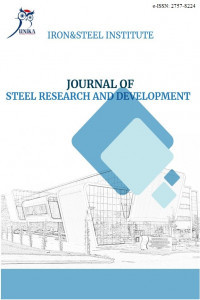Toz Metalurjisi Yöntemi ile Üretilen Farklı Oranlarda Nikel İçeren Mo Çeliklerinin Mekanik Özelliklerinin İncelenmesi
Çelikler, içerisinde en fazla %2,06 C(karbon) içeren demir esaslı malzemelerdir. Mangan, Fosfor, Kükürt ve Silisyum üretim sırasında hammaddeden kaynaklanan elementlerdir ve çelik bünyesinde belirli oranlarda bulunur. Diğer elementler ise (Cr, Ni vb.) istenilen miktarlarda çelik bünyesine eklenir. Bu eklemeler istenilen özelliğe göre değişkenlik gösterir ve çelik malzeme bu alaşım elementleri sayesinde çok daha geniş bir kullanım alanına sahip olmuştur. Bunun en net göstergesi alaşımlı çeliklerin günümüzde en çok kullanılan mühendislik malzemesi olmasıdır.
Bu çalışmada Toz Metalürjisi (TM) yöntemi ile Fe matris içerisine ağırlık olarak 0,55 grafit ve % 3 Mo ilavesinin yanı sıra farklı oranlarda (0-1 ve 3 Ni) Ni ilave edilmiştir. Elde edilen toz malzeme ASTM E8M standartlarında tasarlanmış çekme numunesi şeklinde kalıp içerisine doldurulmuş ve 750 Mpa presleme basıncında tek yönlü sıkıştırılmıştır. Bu işlem sonucunda üretilen numuneler sinter fırınında 1400 ⁰C sıcaklıkta argon atmosferinde sinterlenmiş ve farklı kombinasyonlarda alaşımlı çelik malzeme üretimi gerçekleştirilmiştir. Farklı kimyasal bileşime sahip çelik numunelere çekme testi uygulanmıştır. % ağırlık olarak Ni alaşım elementlerinin oranlarının artması sonucunda mekanik özelliklerde artış tespit edilmiştir.
Anahtar Kelimeler:
Toz Metalürjisi, Mo Alaşımlı Çelikler, Ni ilavesi, Mekanik Özellikler
Investigation of Mechanical Properties of Mo Steels Containing Nickel in Different Ratios Produced by Powder Metallurgy Method
Steels are iron-based materials containing up to 2.06% C (carbon). Manganese, Phosphorus, Sulfur and Silicon are elements originating from the raw material during production and are found in certain proportions within the steel. Other elements (Cr, Ni etc.) are added to the steel in desired amounts. These additions vary according to the desired feature and the steel material has a much wider usage area thanks to these alloying elements. The clearest indicator of this is that alloy steels are the most widely used engineering material today.
In this study, 0.55 wt% graphite and 3% Mo addition as well as different (0-1 and 3 Ni) Ni were added into the Fe matrix by Powder Metallurgy (TM) method. The obtained powder material was filled into the mold in the form of a tensile specimen designed in ASTM E8M standards and compressed in one direction at a pressing pressure of 750 Mpa. The samples produced as a result of this process were sintered in the sinter furnace at 1400 ⁰C in an argon atmosphere and alloyed steel materials in different combinations were produced. Tensile test was applied to steel samples with different chemical compositions. As a result of the increase in the % (percentage) weight ratios of the Ni alloy elements, an increase in the mechanical properties was determined.
Keywords:
Powder Metallurgy, Mo Alloy Steels, Ni addition, Mechanical Properties,
___
- 1. Chen, T.-C., Chou, C.-C., Yung, T.-Y., Tsai, K.-C., & Huang, J.-Y. (2016). Wear behavior of thermally sprayed Zn/15Al, Al and Inconel 625 coatings on carbon steel. Surface and Coatings Technology, 303, 78-85.
- 2. Chrome, H. H. (2022). Twin Wire Arc Spray. Retrieved from https://hausnerinc.com/industrial-hard-chrome-plating-services/twas/
- 3. Fantozzi, D., Matikainen, V., Uusitalo, M., Koivuluoto, H., & Vuoristo, P. (2017). Chlorine-induced high temperature corrosion of Inconel 625 sprayed coatings deposited with different thermal spray techniques. Surface and Coatings Technology, 318, 233-243.
- 4. Fitriyana, D., Caesarendra, W., Nugroho, S., Haryadi, G., Herawan, M., Rizal, M., & Ismail, R. (2020). The Effect of Compressed Air Pressure and Stand-off Distance on the Twin Wire Arc Spray (TWAS) Coating for Pump Impeller from AISI 304 Stainless Steel NAC 2019 (pp. 119-130): Springer.
- 5. Kaur, M., Singh, H., & Prakash, S. (2008). A survey of the literature on the use of high velocity oxy‐fuel spray technology for high temperature corrosion and erosion‐corrosion resistant coatings. Anti-Corrosion Methods and Materials.
- 6. Kumar, M., Singh, H., & Singh, N. (2013). Study of Ni-20Cr coatings for high temperature applications-a review. Archives of Metallurgy and Materials, 58.
- 7. Liu, H., Tan, C. K. I., Wei, Y., Lim, S. H., & Lee, C. J. (2020). Laser-cladding and interface evolutions of inconel 625 alloy on low alloy steel substrate upon heat and chemical treatments. Surface and Coatings Technology, 404, 126607.
- 8. Merino-Millan, D., Múnez, C. J., Garrido-Maneiro, M. Á., & Poza, P. (2022). Alternative low-power plasma-sprayed inconel 625 coatings for thermal solar receivers: Effects of high temperature exposure on adhesion and solar absorptivity. Solar Energy Materials and Solar Cells, 245, 111839.
- 9. Padmini, B., Bhosale, D. G., & Niranjan, H. (2021). A study of T11 boiler steel protection by cold sprayed Inconel 738 coating against high temperature erosion. Surfaces and Interfaces, 23, 101002.
- 10. Shayanfar, P., Daneshmanesh, H., & Janghorban, K. (2020). Parameters optimization for laser cladding of inconel 625 on ASTM A592 steel. Journal of Materials Research and Technology, 9(4), 8258-8265.
- 11. Yugeswaran, S., Amarnath, P., Ananthapadmanabhan, P., Pershin, L., Mostaghimi, J., Chandra, S., & Coyle, T. (2021). Thermal conductivity and oxidation behavior of porous Inconel 625 coating interface prepared by dual-injection plasma spraying. Surface and Coatings Technology, 411, 126990.
- 12. Zhou, S., Xu, T., Hu, C., Wu, H., Liu, H., & Ma, X. (2021). A comparative study of tungsten carbide and carbon nanotubes reinforced Inconel 625 composite coatings fabricated by laser cladding. Optics & Laser Technology, 140, 106967.
- Başlangıç: 2020
- Yayıncı: Karabük Üniversitesi
Sayıdaki Diğer Makaleler
Sementasyon İşleminin Sıcak İş Takım Çeliklerinin Aşınma Davranışına Etkisinin İncelenmesi
Sharfuldeen Ali Abourawi ALFAYDH, Harun ÇUĞ, Yasin AKGÜL, Alper İNCESU, Andinet Kumella ETİCHA, Salih Birhanu AHMED
Borlama prosesinin 16MnCr5 çeliklerinin aşınma performansına etkisi
Ali Yağız ŞAHİN, Muhammet Emre TURAN
Senol LİMAN, Bünyamin ÇİÇEK, Tuna AYDOĞMUŞ
Mehmet Akif ERDEN, Ramazan ÖZMEN
Mehmet Akif ERDEN, Abkar Ahmed Ali DHAIBAIN, Ahmet Serdar GÜLDİBİ
